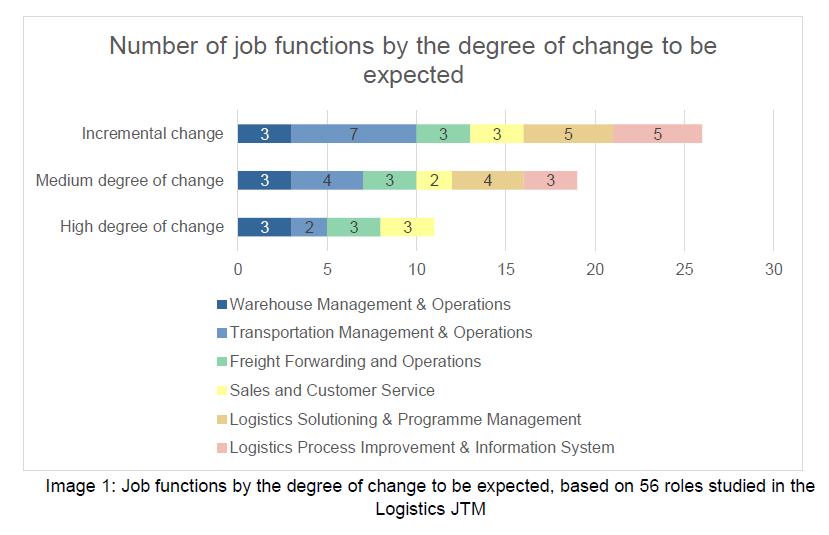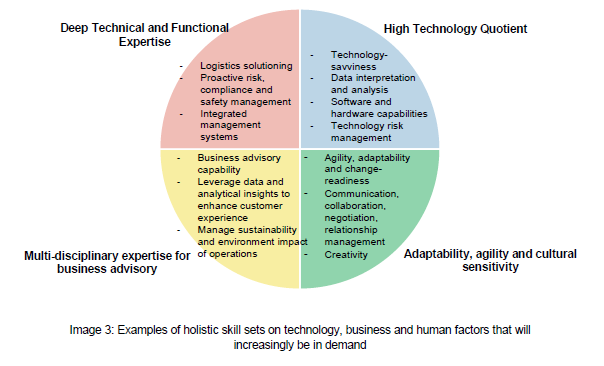Jobs Situation Report 28th Edition
JOB ROLES IN THE LOGISTICS SECTOR WILL UNDERGO CHANGE WITH THE ADOPTION OF INDUSTRY 4.0 TECHNOLOGIES
Jobs Transformation Map for logistics sector guides business transformation and safeguards jobs
1. The Jobs Transformation Map (JTM) for the Logistics sector championed by the Economic Development Board (EDB) and supported by the Ministry of Manpower (MOM), Enterprise Singapore (ESG), SkillsFuture Singapore (SSG) and Workforce Singapore (WSG) deep dives into the impact of Industry 4.0 (I4.0) technology solutions1 on Singapore’s Logistics workforce. This includes how job roles will evolve, the new skills and capabilities required to contribute in the new work environment and the strategies employers and workers can adopt to prepare for changes in the near to medium-term. Companies can use the JTM to anticipate transformation within the sector as well as adopt recommended strategies to enhance their competitiveness.
Digital and technology solutions will generate significant benefits for the sector
2. Digital and technology solutions are a necessary means for companies to scale up. For a start, Logistics companies, in particular the SMEs, can deploy digital technology and automated solutions to improve productivity and reduce reliance on manpower, making it easier to scale up operations.
3. In the longer-run, Logistics companies need to embrace the I4.0 technology transformations to help them address their strategic priorities and gain competitive advantage. This way, they can (i) move towards customer-centricity, (ii) build agile and resilient supply chains and (iii) innovate and pivot continuously to stay sustainable. Businesses will have to simultaneously build technology and workforce capabilities in order to transform effectively, and create good jobs to build a strong talent pipeline.
Changes to job tasks in Logistics will affect all roles and workers
4. With I4.0 adoption, existing job roles in the sector will undergo change in the next three to five years. Of the 56 job roles studied, all will undergo some changes, with 30 job roles (54%) (about 36,000 workers) experiencing at least a medium degree of change in job tasks, which will require job redesign or undergo displacement. The remaining 26 job roles are expected to change incrementally. These affected roles cut across various functions as reflected in the illustration below.

5. New roles that were traditionally not found in the Logistics sector are beginning to emerge with technology adoption, and this is expected to accelerate as businesses adopt I4.0 technology. Workers in the Logistics sector or jobseekers considering making a switch can refer to the emerging roles and skills sets required to prepare themselves. Some examples include:
6. As transactional tasks – such as those which are manual, labour-intensive and repetitive – become automated, some job roles may potentially be disrupted. Workers in such roles will need to reskill to take on redesigned roles or be redeployed into new roles. Examples include Material Handling Equipment Operator and Warehouse Assistant roles, as I4.0 solutions significantly reduce the need for manual sorting, routing, loading and unloading of cargo items. Workers in such roles can pick up skills in operating automated storage and retrieval systems (ASRS) and drones, robotic and automation system maintenance, and transit into new roles such as ASRS Operators, Drone/Automated Guided Vehicle Coordinators and Automation Technicians.
7. Existing job roles such as Freight Inspector, Import/Export Specialist, Transport Executive/Manager, Inventory Management Manager and Vertical Product Manager, will also be augmented by technology to boost efficiency. Workers in these roles will also be required to oversee, customise and manage the I4.0 solutions adopted by the company. As such, they will be increasingly expected to be able to make sense of data and provide analytical insights from these solutions.
8. On the whole, companies are looking for employees with balanced and holistic skill sets on technology, business and human factors as they look for talents who are agile and can adapt to the rapid pace of change.

Businesses and workers must adapt and value-add through job redesign
9.The redesign of an existing job role allows a company to increase the attractiveness and appeal of the role to new and existing talents, raise productivity and enable workers to deliver greater value for the business with more value-adding tasks such as overseeing and managing Internet of Things (IoT) solution, troubleshooting, and performing data analytics. This will also extend the career longevity for workers which will allow them to continue to contribute to the business.
10. The Government, together with our tripartite partners, provide businesses with support to redesign jobs through various Job Redesign and Redeployment initiatives. Logistics companies can consider tapping on:
a. Industry 4.0 Human Capital Initiative (IHCI) by WSG and the Singapore Business Federation, which aims to help companies strengthen their workforce transformation and job redesign capabilities to augment the implementation of I4.0 solutions in a sustainable manner.
b. The Support for Job Redesign under Productivity Solutions Grant (PSG-JR) by WSG for enterprises to engage pre-approved job redesign consultants who will help redesign existing work processes, tasks and responsibilities to raise productivity and efficiency as well as to support business transformation efforts.
c. Career Conversion Programmes (CCPs) by WSG for new hires and existing logistics workers to undergo skills conversion to be redeployed into emerging job roles as their current roles become redundant due to business transformation and technology adoption. (Refer to Annex A for full list of CCPs).
i. As of September 2021, close to 650 workers from 226 companies (including logistics companies and companies with logistics function) have tapped on the various WSG’s CCPs to support new hires and redeploying existing workers to take on new roles.
d. Employers with Company Training Committees can also partner NTUC to develop their customised business transformation plan through the Operation & Technology Roadmap process.
11. ST Logistics is an example of a company that has led the change to automate their processes and tapped on the CCP for the Logistics sector to equip 38 workers with skills to take on the new tasks over the last two years. One of the functions performed by the logistics company is to work with e-commerce retailers to pack and process online orders.
a. The process of packing the online orders has been greatly enhanced with the adoption of ASRS, and the pick-to-light technology. The ASRS automatically retrieves containers where each item is stored from the warehouse storage, and the pick-to-light technology indicates to the operator which items, and the quantity, to pick out from the container.
i. This makes it easier for operators to work quickly, process more orders within the same amount of time, and reduces the likelihood of errors in the packing of orders.
b. Through the CCPs, existing PMETs and rank-and-file workers are upskilled to learn how to use such technologies to improve efficiency and increase the output for the company.
i. Backend executives learn to leverage data insights to drive productivity and cater to customers’ preferences.
ii. At the warehouses, ST Logistics deploys Automated Mobile Robots (AMRs), which will extract the bulkier goods to the operator, instead of having the operator make use of a forklift to pick out the items.
iii. The entire system allows operators to be stationed at a single location while the goods are brought to them for packing, saving time and reducing the labour-intensiveness of the job.
c. Through the Company Training Committee, ST Logistics, which is unionised under the Supply Chain Employees’ Union (SCEU), also worked with the Union to shape the direction of the training requirements and outcomes, within the Skills Management System powered by Jobkred. The system allowed ST Logistics to identify skills gaps when they redeploy or reskill their workers to take on new roles in the CCPs.
12. Another example is that of Lim Siang Huat (LSH), a Food Distributor and Cold Chain Logistics provider. With the support of ESG’s Enterprise Development Grant, LSH rolled out a Goods-to-Man Loose Picking ASRS which is integrated with its Warehouse Management System and Pick-to-Light System. This seamless linkage enables the company to batch multiple picking orders simultaneously, and automate the picking and placing from fixed locations, which eliminates manpower required to manually place items back in the warehouse. Today, LSH enjoys picking accuracy of up to 99.9% and warehouse operators see 50% time saving for each job order. Warehouse operators are also upskilled with greater digital acumen to operate, maintain and troubleshoot the ASRS.
Upskilling and Reskilling Key to Safeguarding Workers
13. Workers above the age of 40 make up a significant proportion (63.1%) of local workers in Logistics in 2019, and those above 55 make up around 27.5% of the local workforce in Logistics2. With their experience and expertise built up over the years, employers can continue to tap on this talent pool through upskilling and reskilling. Besides taking up redesigned roles where tasks may be automated, they can continue to contribute in roles such as Health, Safety and Environment Manager, Key Account Executive, Logistics Solutions Specialist, or Process Improvement Manager.
14. Upskilling and reskilling will have to be a sustained and continuous effort not just for older workers, but also for younger workers whose job tasks are constantly shifting with I4.0 adoption. Companies can consider:
a. Introducing in-house structured programmes to build I4.0 skills or working with dedicated consultants through the IHCI programme
b. Making use of programmes by external training providers and tapping on Government support in the form of ESG’s SkillsFuture Enterprise Credit, SSG’s Enhanced Training Support for SMEs, WSG’s PSG-JR or EDB’s Training Grant for Company
c. Tapping on WSG’s CCPs or IMDA’s Tech Immersion and Placement Programme to equip workers with tech-skills needed to take on roles such as web developers, software developer, UX designers and data analysts
d. Partnering with unions to drive broad-based digital capability-building interventions and trainings for workers to uplift digital literacy and acumen.
Taking Action
15. We encourage Logistics companies to make use of the JTM insights to prepare their businesses and workforce for the future. Companies that need advice and support can approach EDB, ESG, WSG or NTUC. Workers considering a career switch or seeking upskilling and reskilling can approach WSG or NTUC’s e2i.
For more information:
16. To find out more about:
- Logistics Jobs Transformation Map: https://www.wsg.gov.sg/content/about/jobs-transformation-maps/logistics-sector.pdf
- WSG’s programmes and career advisory and matching services, please visit www.mycareersfuture.gov.sg/careercoaching (QR code below) or call WSG’s hotline at 6883 5885.
- WSG’s CCPs, please visit https://conversion.mycareersfuture.gov.sg/Portal/ProgramListing.aspx?source=PCP
- WSG and SCALA’s CCP for the Logistics Sector, please visit: https://www.scala.com.sg/pcp/redeployment/
- WSG and SBF’s IHCI programme: https://ihci.sbf.org.sg/
- Upcoming engagement and outreach events organised by WSG and NTUC’s e2i, jobseekers can visit https://www.ssg-wsg.gov.sg/events.html or https://e2i.com.sg/events/.